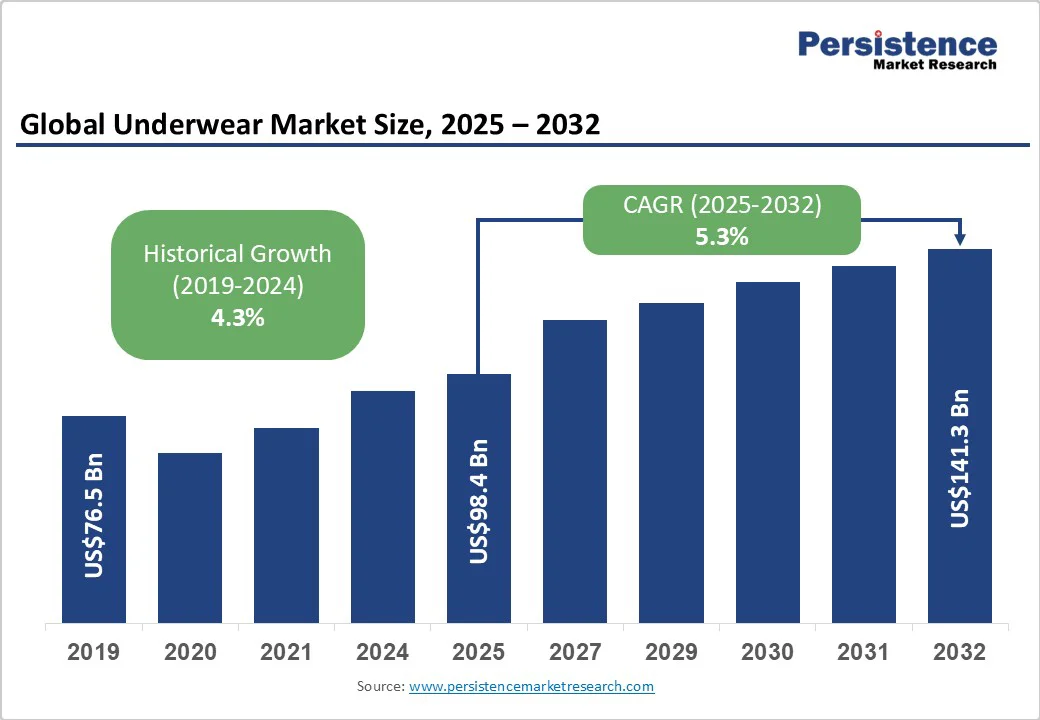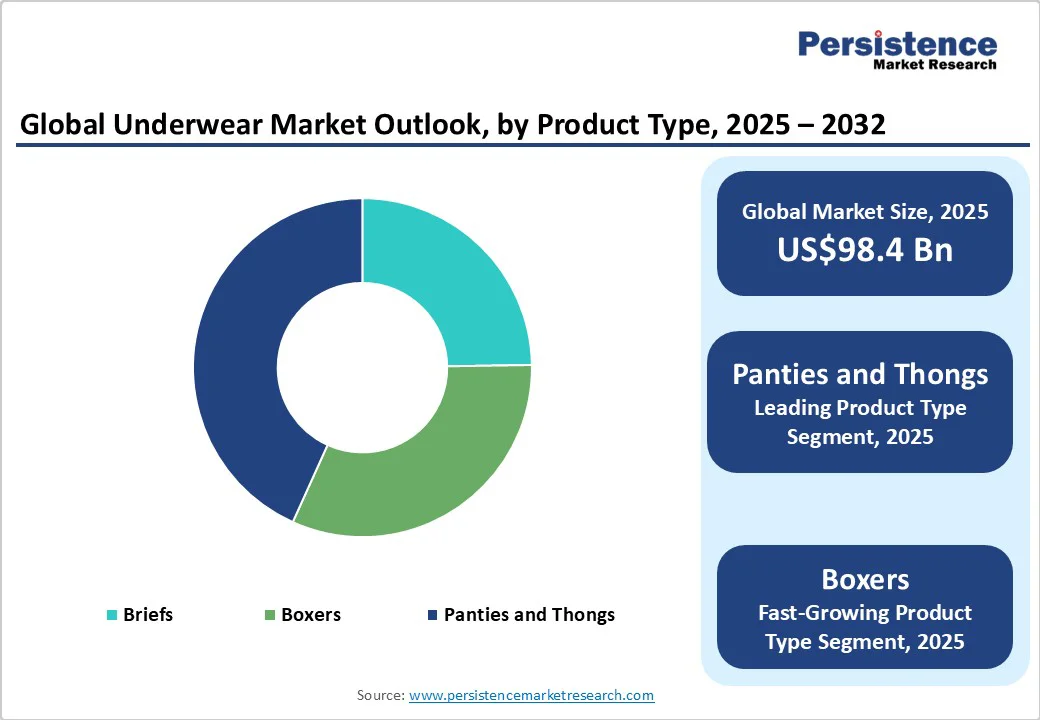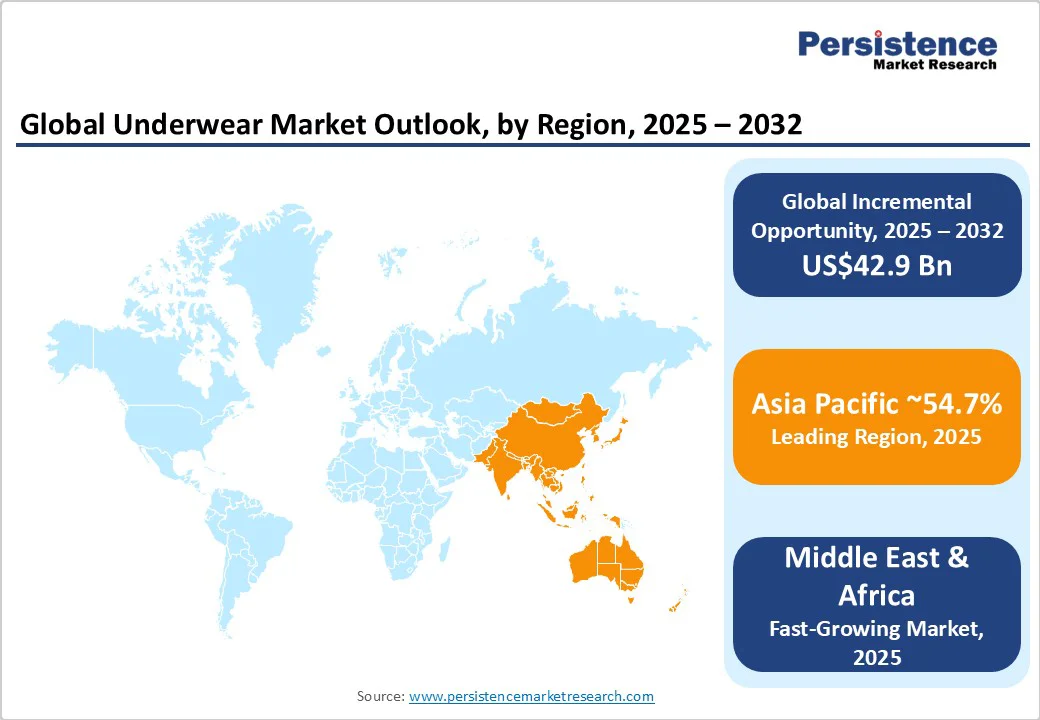ID: PMRREP3465| 155 Pages | 9 Oct 2025 | Format: PDF, Excel, PPT* | Consumer Goods

The global underwear market size is likely to be valued at US$98.4 Billion in 2025 and is estimated to reach US$141.3 Billion in 2032, growing at a CAGR of 5.3% during the forecast period 2025 - 2032, driven by increasing consumer demand for breathable, moisture-wicking fabrics as well as designs that support active lifestyles. Bamboo and organic cotton are appealing to eco-conscious consumers.
| Key Insights | Details |
|---|---|
| Underwear Market Size (2025E) | US$98.4 Bn |
| Market Value Forecast (2032F) | US$141.3 Bn |
| Projected Growth (CAGR 2025 to 2032) | 5.3% |
| Historical Market Growth (CAGR 2019 to 2024) | 4.3% |

The increasing demand for athleisure has influenced the global market, leading to a surge in functional designs that blend performance with comfort. Consumers are seeking underwear that delivers breathability, moisture-wicking properties, and support, aligning with the active lifestyles prevalent today.
Brands are responding by incorporating athletic-inspired elements into their designs, such as seamless construction and stretchable fabrics, to cater to this surging preference. For instance, Quo's active thong combines seamless design with antimicrobial, moisture-wicking materials, addressing the demand for hygiene and comfort during workouts. This trend reflects a broad shift toward performance-oriented intimate wear, pushed by the fusion of fashion and functionality in the athleisure movement.
The expansion of e-commerce has revolutionized the market, providing brands with the opportunity to reach a global audience. Online platforms enable consumers to access a wide variety of styles, sizes, and brands from the comfort of their homes, breaking down geographical barriers.
This accessibility has led to increased competition and development as brands strive to deliver unique products and personalized shopping experiences. Companies such as ThirdLove are utilizing AI-backed fitting tools to improve personalization, catering to diverse consumer requirements. The growth of e-commerce in the apparel segment shows the shifting dynamics of the market, emphasizing convenience in the consumer shopping experience.
The market faces challenges due to a fragmented structure with multiple brands vying for consumer attention. This saturation leads to bold pricing strategies, often resulting in price wars that erode profit margins. For example, China-based textile exports to the EU surged by 20% in the first half of 2025, propelled by redirected shipments from the U.S.
Manufacturers are cutting prices to gain market share, intensifying competition for Europe-based producers. The rise of fast-fashion retailers and online marketplaces has further fragmented the market, delivering consumers a plethora of choices at competitive prices. Brands are compelled to differentiate themselves to maintain consumer loyalty amid this competitive landscape.
Geopolitical tensions have drastically impacted the global cotton supply chain, affecting market growth. Trade disputes such as the U.S.-China trade war have led to tariffs that disrupt established supply chains. For instance, the U.S. imposed tariffs on cotton exports, leading to an excess supply and dampened demand.
This compelled brands to reassess sourcing strategies. Natural disasters such as floods in Bangladesh have also strained cotton supplies. The floods disrupted transportation routes, preventing cotton from reaching factories, leading to a 50% reduction in garment production.
The shift toward sustainable materials is changing the global market, with bamboo and recycled fibers gaining prominence. Bamboo, known for its rapid growth and minimal water requirements, provides a renewable alternative to traditional fabrics. Brands such as Boody have capitalized on this trend by introducing shapewear made from bamboo blends, emphasizing comfort and eco-friendliness.
Similarly, recycled polyester, derived from post-consumer plastic bottles, is being utilized to create breathable and durable underwear options, appealing to environmentally conscious consumers. This trend caters to the rising demand for sustainable fashion, encouraging brands to innovate and adopt eco-friendly materials in their product lines.
The integration of technology into underwear is creating new avenues for health monitoring. Companies such as Fibra are developing smart underwear embedded with sensors to track vital biomarkers, including pH levels and stress indicators, providing users with real-time health insights.
These innovations cater to the growing consumer interest in wearable health technology, delivering a discreet and comfortable means of monitoring personal well-being. By incorporating such technologies, the market is not only improving product functionality but also contributing to the broad health tech ecosystem.
Panties and thongs are predicted to dominate with a share of around 34.6% in 2025, due to their minimal visibility under clothing, making them ideal for wearing with tight-fitting or sheer garments. Thongs, in particular, are popular for their sleek design, which reduces the likelihood of riding up during daily activities. Their lightweight nature and minimal fabric coverage contribute to comfort and breathability.
Boxers continue to maintain popularity due to their comfort and practicality. Their loose fit provides breathability and freedom of movement, making them suitable for various activities. The relaxed design also reduces the risk of chafing, appealing to individuals seeking comfort throughout the day.
Also, boxers are often perceived as timeless and versatile, fitting well with different body types and personal styles. Their enduring appeal lies in their combination of comfort, functionality, and classic design.
Cotton is speculated to hold a share of approximately 45.8% in 2025, due to its breathability and moisture-wicking properties. These help maintain a dry and comfortable environment, reducing the risk of infections. Its hypoallergenic nature makes it ideal for sensitive skin, minimizing irritation and discomfort. Cotton's natural fibers also allow for better air circulation, thereby promoting intimate health.
Synthetic underwear, made from materials such as polyester, nylon, and spandex, is gaining traction due to its durability, elasticity, and moisture-wicking capabilities. These fabrics are engineered to provide a snug fit and support, making them suitable for athletic activities. Developments in synthetic materials have led to improved breathability and comfort, addressing some of the traditional drawbacks.
Men are likely to register a share of nearly 53.6% in 2025, backed by comfort, functionality, and evolving fashion trends. The preference for boxer briefs, which deliver a blend of support and comfort, has contributed to this dominance.
Brands such as Calvin Klein and Hanes have capitalized on this by providing a range of styles and materials that cater to men's requirements. The rise of athleisure and increased awareness of personal grooming have further bolstered men's engagement with the market.
Women represent a significant portion of the global market, attributed to the increasing demand for fashionable and comfortable lingerie. The rise of e-commerce platforms delivering a wide variety of choices and a surging emphasis on body positivity and inclusivity have also fueled growth.
Brands such as Victoria's Secret, Aerie, and Marks & Spencer have been at the forefront, providing diverse styles and sizes to cater to women's evolving preferences. For instance, Marks & Spencer's introduction of leak-proof period pants and stoma-friendly underwear demonstrates a commitment to addressing specific requirements in the female demographic.

In 2025, Asia Pacific is projected to record a share of approximately 54.7%, owing to rising disposable income and a surging middle class seeking comfort and style in intimate apparel. China and India are seeing increased demand for premium and luxury underwear, with brands such as Aimer and Neiwai blending traditional aesthetics with modern designs to cater to evolving tastes.
Technological innovation is also driving growth. Seamless underwear, which offers better fit and comfort, is gaining popularity. Brands are embracing novel fabrics and ergonomic designs to appeal to consumers prioritizing performance and style. E-commerce is transforming retail in the region. Online lingerie sales in Asia Pacific are expected to surge steadily, giving consumers access to a wide variety of brands and styles without geographical limitations.
In the Middle East, modesty plays a prominent role in influencing lingerie choices. Hence, there is a preference for designs that provide more coverage, complying with cultural and religious values. This trend is evident in the popularity of full-coverage bras and shapewear that provide support while maintaining modesty.
In Africa, there is a surging demand for diverse lingerie options, including both traditional and contemporary designs, as consumers seek products that cater to various tastes and preferences.
The luxury lingerie segment is also witnessing growth in the Middle East and Africa. This is attributed to rising affluence and a growing interest in luxury fashion. International brands are recognizing the potential of this market, with companies such as Skims opening their first physical store in Dubai, marking their debut in the Gulf region's luxury market.
Consumers in North America are now prioritizing comfort, functionality, and inclusivity in their underwear choices. Brands are responding by delivering a diverse range of products that cater to various body types and preferences. For instance, Victoria's Secret has reimagined its fashion shows to promote inclusivity, featuring diverse body types and expanding product lines to include mastectomy and sports bras.
Despite its prominent position, Victoria's Secret has faced challenges, including declining sales and store closures. The company announced the closure of 20 to 35 stores in 2025, continuing from over 300 U.S. store closures between 2020 and 2023. This trend reflects broad shifts in consumer behavior, with increased preference for online shopping and value-oriented brands.

The global underwear market is characterized by a blend of established brands, emerging direct-to-consumer (D2C) start-ups, and shifting consumer preferences toward comfort, sustainability, and value.
Leading players such as Victoria's Secret are focusing on sustainability by sourcing cotton directly from Alabama family farms, including women-owned and Black-owned farms. Tommy John has redefined men's underwear with a focus on comfort and functionality. Calvin Klein continues to innovate by launching new logo treatments and materials for stylish, everyday comfort.
Market leaders in the underwear segment focus on innovation through smart fabrics and sustainable materials, cost leadership via efficient manufacturing, and expansion into emerging regions. Key differentiators include superior comfort, brand identity, and eco-conscious designs. Emerging trends highlight D2C models, subscription services, and personalized fitting solutions, transforming consumer engagement and loyalty.
The underwear market is projected to reach US$98.4 Billion in 2025.
The rising demand for comfort and sustainable fabrics is a key market driver.
The underwear market is poised to witness a CAGR of 5.3% from 2025 to 2032.
Expansion of smart health-monitoring underwear and penetration into emerging markets via e-commerce are the key market opportunities.
PVH Corp., Victoria’s Secret & Co., and Hanesbrands Inc. are a few key market players.
| Report Attribute | Details |
|---|---|
| Historical Data/Actuals | 2019 - 2024 |
| Forecast Period | 2025 - 2032 |
| Market Analysis | Value: US$ Bn |
| Geographical Coverage |
|
| Segmental Coverage |
|
| Competitive Analysis |
|
| Report Highlights |
|
By Product Type
By Fabric Material
By End-user
By Distribution Channel
By Region
Delivery Timelines
For more information on this report and its delivery timelines please get in touch with our sales team.
About Author